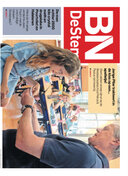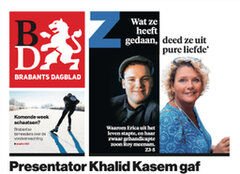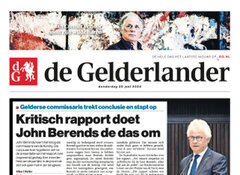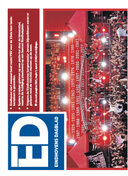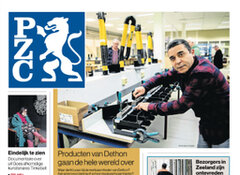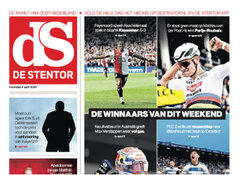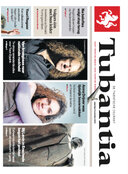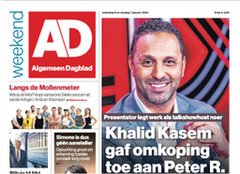Unpopular, but essential: why we write about secret meetings
Why does de Stentor also write stories that don’t appeal to many readers? Because it is our journalistic duty to monitor the government and expose malpractices. For example, when Gep Leeflang revealed that there were secret meetings at local authorities.
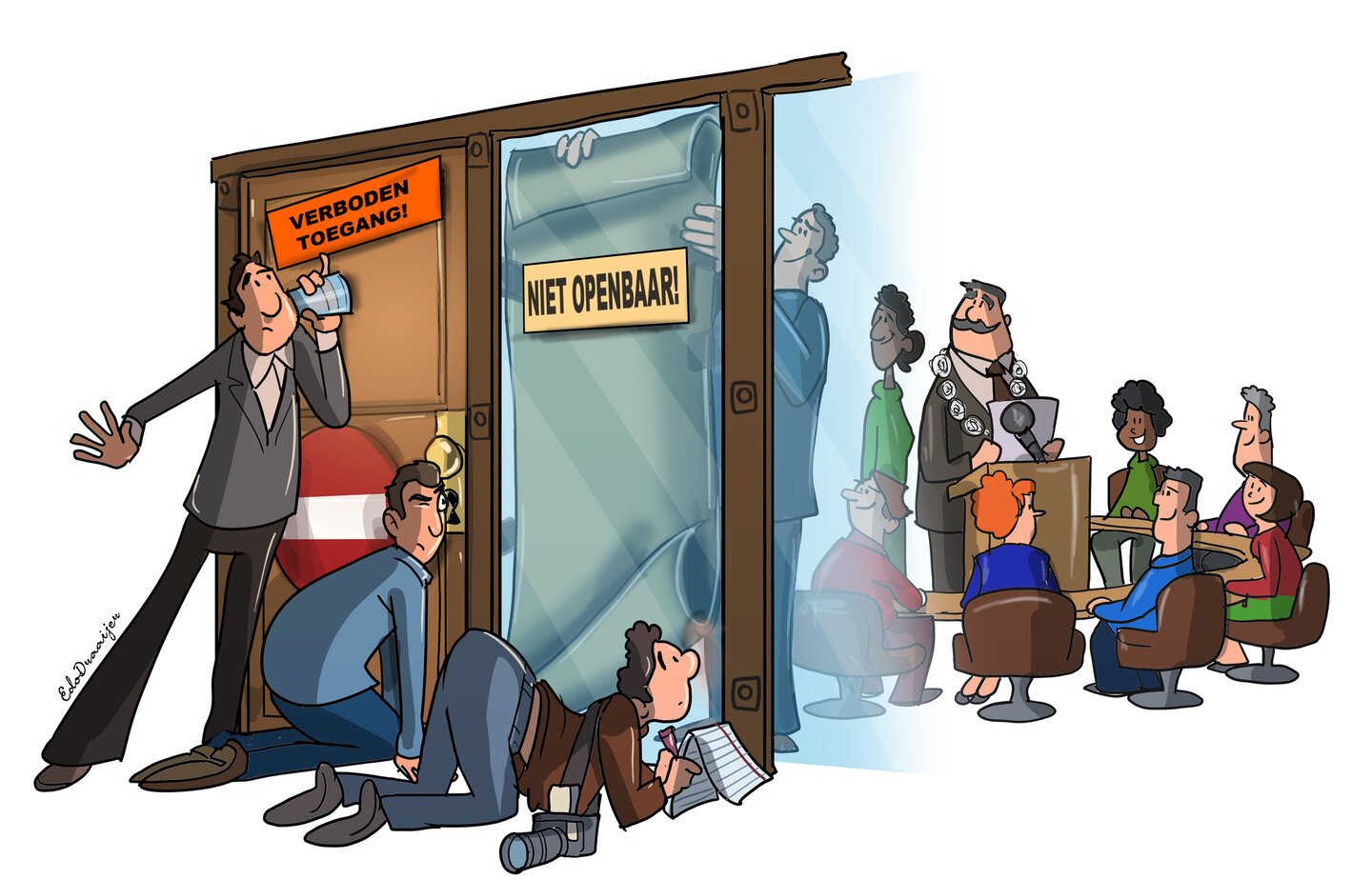
W
hy do local authorities hold so many meetings behind closed doors? This was a question that kept nudging at de Stentor journalist Gep Leeflang. He established that local authorities were breaking the law on a massive scale. This was a story for which he won this year’s ‘Tegel’’, the most important prize in Dutch journalism. Monitoring the government and addressing what is wrong. That is our role, our duty. Gep Leeflang immersed himself in the world of backroom meetings. This not only resulted in the revealing story that local authorities are breaking the law on a massive scale, but also a series of follow-up stories. The Municipalities of Epe and Staphorst are now questioning the practice of holding backroom meetings.
This is where regional brands such as de Stentor can make the difference. But this is also a story that does not appeal to a large audience. The data that provides us with an understanding of how well stories are found and read, shows that such subject matters are not very popular among the public. Personal stories and breaking news are often preferred.
Score well
This does not make it any less important to decide to invest time in subject matters that are ‘tougher’. Articles that may not directly affect our audience personally, but are significant for everyone. After all, we also see it as our role to monitor the government ‘on behalf of the public’.
This is the reason why many of us went into journalism
Our online reach has declined over the past year. It actually hurts a little that we are reaching fewer readers with our journalism. One of the main reasons for this is that social media are showing less news in their algorithms, so that we are unable to draw as many people towards us. But it is a conscious choice not just to make stories that we know in advance will reach a lot of people – to put it bluntly, to ‘score well’.
The trick is to write and present stories about malpractices at institutes and by executives, for example, in such a way that we reach the broadest and largest possible readership. For our online platforms this means a catchy heading and effective images, still or moving. And the story must be embellished with graphs, text boxes, audio, video and the author’s CV. Digital journalism requires much more attention than we were used to in newspapers.
We occasionally have heated discussions within the editorial team about which story should be placed at the top of the website: the best running story (i.e. the most readers) or the article with the greatest social impact? Against our better judgement (the numbers), we often choose the latter because the editorial team is heavily influenced by ‘the journalistic duty’.
But it is a difficult issue. We need as many (paying) readers as possible for the brand to remain successful, but we don’t want to drift away from our social role. Ultimately, it is the mix of different types of stories that should ensure that as many readers as possible read de Stentor online or in print every day. From hard-hitting political or societal news to human interest stories, from revealing reports to brain-teasing opinion pieces. That is what de Stentor stands for.

Reporter Gep Leeflang
Interaction
The reader’s voice
We introduced something new this year: the guest column. Every week we invite a reader to share their opinion, ideas and experiences in our newspaper. In addition to opinion pieces, guest writers and reader’s comments, this is a nice add-on to our reader platform.
The guest column enables us to show that readers are more than just news consumers; they are also active contributors. Their voices are heard. Lively discussions are often initiated online. This section helps to further strengthen the interaction and engagement between our editorial team and our readers.
The weekly columns offer a diversity of perspectives from our society, from personal stories to piercing comments. Readers feel more valued and heard, which has already resulted in many positive reactions.
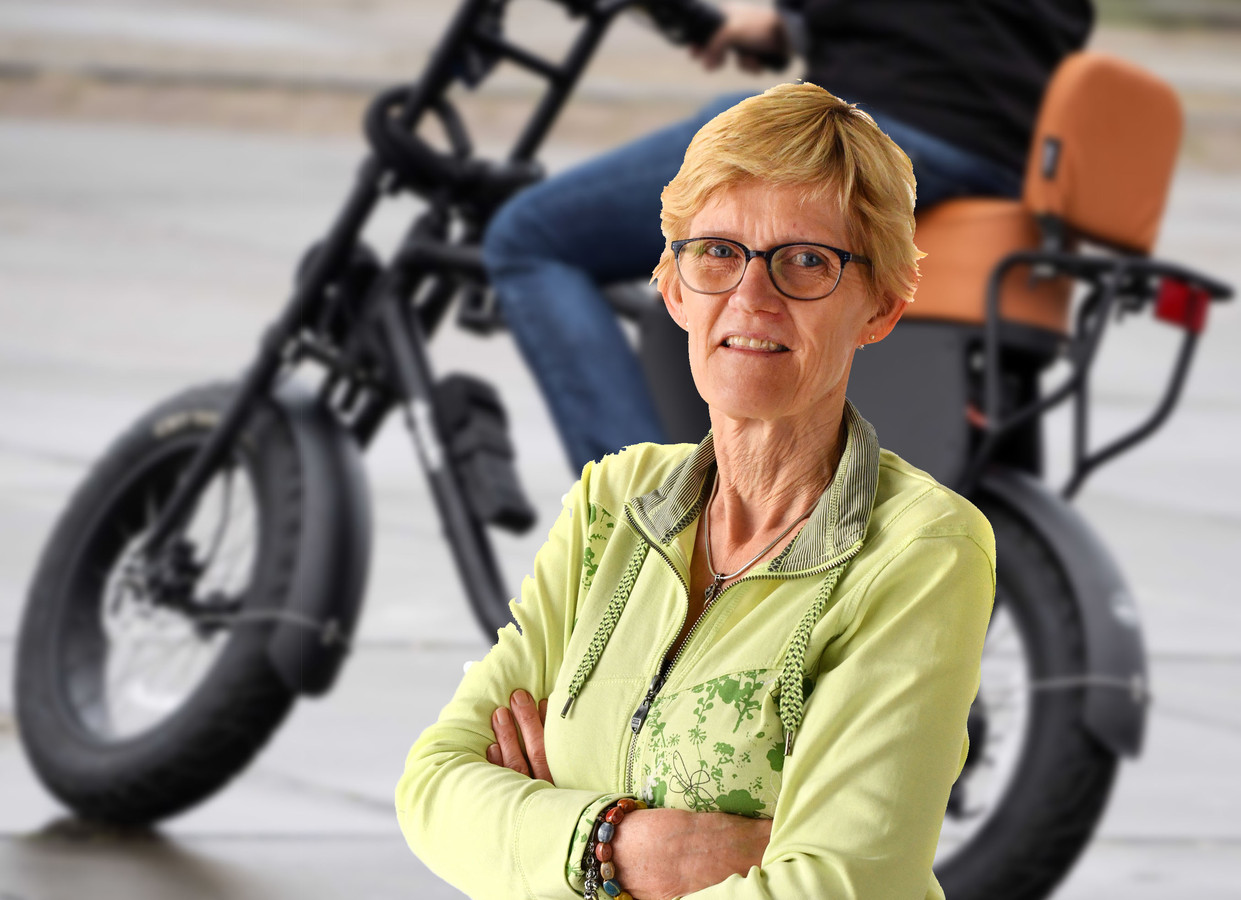
Read column
Wilma Koller from Vaassen is the second of four guests selected by the editorial board following the introductory invitation to become a ‘columnist for a day’
Seeing is believing
What if a video tells you more than an entire article? What if the moment itself, captured on film, conveys the essence of the story better than a thousand words? Videos are no longer an add-on, but an essential part of our journalistic work.
We do this for an important reason: if we can show it, then we show it. Take that world-class goal scored at the local amateur football club, for example. Or a wolf on the loose in a residential area. Seeing is believing.
Videos are not just an add-on, but also an extension to our stories. In cases where text cannot explain something, a video can show exactly what words cannot capture.
Furthermore, these days video is sometimes the only thing that reaches part of our audience. What is the first thing that Gen Z asks for when we talk to them about the news? Exactly.
But videos are not just for Gen Z. They are for everyone who wants to understand news quickly and visually. This is why we use them more and more to make complex subject matters easier to understand. Visual aids help to make abstract ideas and extensive studies understandable to a wider audience. The images reinforce the story.
We also use this concept on social media: short videos – less than one minute – enable us to communicate our news in an understandable way. Or to debunk and invalidate fake news.
This calls for new ways of thinking from our editorial teams – thinking in images, not just in text. We’re no longer adding them as an afterthought, but as an integral part of our stories. It’s one of our editorial team’s focus areas: videos are part of your story. A video sometimes says more than a thousand words.
Sylvia Cools
Editor-in-chief of de Stentor


ADR Nieuwsmedia zit in de haarvaten van Nederland
Algemeen Dagblad en de zeven regionale titels van DPG Media vormen één groep: ADR Nieuwsmedia. Binnen deze grootste nieuwsorganisatie van Nederland wordt nauw samengewerkt. Hoe gebeurt dat?
We vragen het onze abonnees in Gelderland, Brabant, Twente of Zeeland elk jaar opnieuw, maar we kennen het antwoord: zij lezen onze sites, apps en kranten vooral vanwege het regionale nieuws. Dat geldt trouwens niet alleen voor lezers uit die genoemde streken. Ook de AD-lezers in en rond Den Haag, Utrecht of Rotterdam zetten ‘lokaal nieuws’ bovenaan hun lijstje van favoriete artikelen. Meteen daaronder staat vaak hun favoriete voetbalclub.
Het enorme belang dat abonnees stellen in nieuws uit hun eigen buurt deed kranten decennia geleden besluiten zich te concentreren op de beste regionale verslaggeving. Voor zaken als binnenlandse politiek, buitenland, economie, cultuur of topsport bundelden ze de krachten in gemeenschappelijke persdiensten. Zo ontstonden de Zuid-Oost Pers, de GPD en de Wegener Persdienst. Die laatste persdienst verdween toen DPG Media tien jaar geleden de regionale kranten van Wegener kocht. AD en de zeven regionale kranten werken sindsdien samen in ADR Nieuwsmedia.
Samenwerken
Een centrale redactie met 200 journalisten van het AD en de samenwerkende titels in de regio, verzorgt vanuit Rotterdam het (inter)nationale nieuws. Zodat De Gelderlander zich kan richten op de eigen provincie en de PZC zich alleen bezig hoeft te houden met Zeeland.
De stroom nieuws gaat niet alleen van Rotterdam naar de regio, maar ook omgekeerd. Als er in Eindhoven of Enschede iets groots gebeurt, delen het ED en Tubantia dit nieuws onmiddellijk met het AD en de andere regionale titels. Het maakt ADR, zeker buiten de Randstad, tot een van de snelste nieuwsorganisaties en zeker de meest wijdvertakte. Want ADR beschikt over ruim 800 journalisten en een netwerk van lokale correspondenten. ADR zit in de haarvaten van Nederland.
Leidt dit tot eenheidsworst? Allerminst. Het nieuws uit Oost-Nederland beheerst de homepage van de Stentor, dat uit de regio Breda de voorpagina van BN DeStem – en zo verder. De lay-out van ADR-kranten en -online-platforms komen overeen, de inhoud verschilt sterk, want elke titel maakt eigen, onafhankelijke keuzes. De eigenheid en uniciteit van de unieke regionale verslaggeving bepaalt immers het succes van een titel. Ruim 900.000 abonnees en bijna vijf miljoen online bezoekers zijn er dagelijks blij mee.
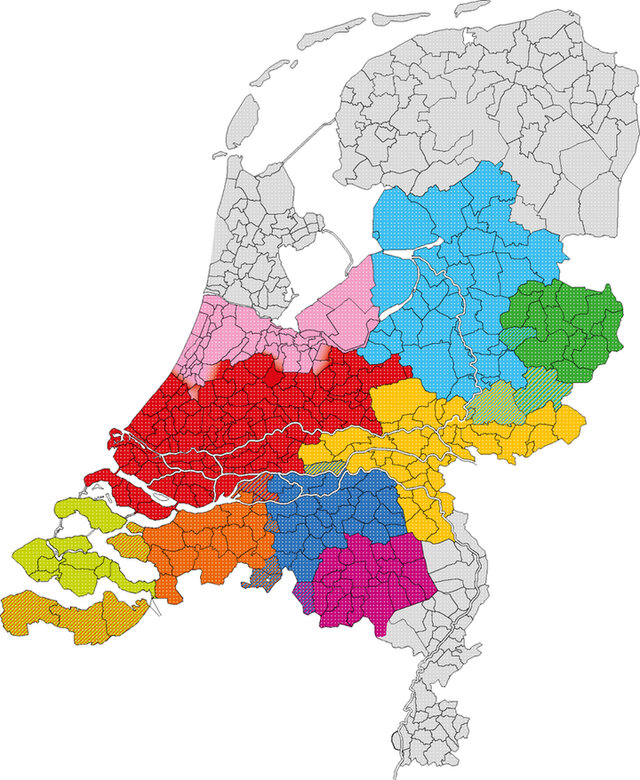
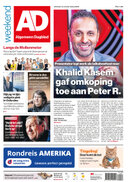
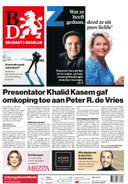
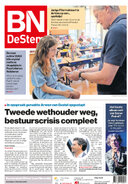
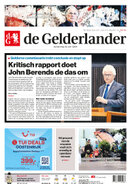
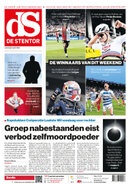
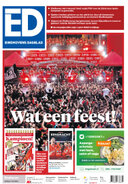
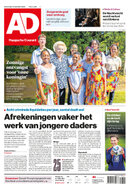
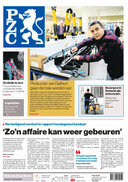
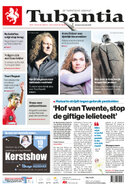
De regionale titels in Nederland
Ad Regio
de Stentor
Tubantia
De Gelderlander
Brabants Dagblad
Eindhovens Dagblad
BN DeStem
PZC
AD Landelijk
Kies jouw locatie

indebuurt.nl
Sinds een aantal jaren maakt ook indebuurt.nl onderdeel uit van ADR. Het gratis platform richt op alles wat een stad leuk maakt voor haar inwoners en is sterk gericht op het bieden van service. Zo geeft indebuurt.nl bezoekers informatie over nieuwe winkels, over uitgaan, activiteiten in de stad en bijzondere plekken. Inwoners worden uitgenodigd de redactie van tips te voorzien, of vrijblijvend teksten, foto’s of video’s aan te leveren. De makers van ‘indebuurt’ hebben de ambitie om gebruikers nauwer bij het stadsleven te betrekken.
indebuurt.nl is actief in 34 steden, vooral in plaatsen waar ook ADR-titels actief zijn. Artikelen van indebuurt.nl staan daarom ook op de sites en apps van de regionale titels van ADR en enkele malen per week in de gedrukte kranten. Per maand bezoeken ruim 2,5 miljoen mensen een van de secties. Daarmee staat ‘indebuurt’ in de top 10 van nieuwssites in Nederland.
Journalistiek & techniek
ADR-redacties maken gebruik van technische innovaties op het gebied van automatisering en kunstmatige intelligentie (AI). Het gebruik van spellingscorrectie is bijvoorbeeld al sinds jaar en dag ingeburgerd. Het is per definitie een journalist die bepaalt welk onderwerp wordt opgepakt en of wat er wordt gepubliceerd. AI wordt – nu nog experimenteel – gebruikt om teksten van bijvoorbeeld persberichten snel samen te vatten of tot een kort artikel te verwerken. Daarnaast kan AI ook suggesties doen voor spelling, grammatica, koppen en ideeën voor verhalen. De journalist bepaalt of suggesties worden overgenomen. We noemen deze werkwijze het mens-machine-mens-principe.
De redactie gebruikt automatisering het meest voor serviceberichten, zoals lokale weerberichten voor alle 342 gemeenten in Nederland. Als de verwachting is dat de temperatuur daalt van 2 naar -2, staat er een zin klaar die deze data-informatie vertaalt naar bijvoorbeeld ‘het gaat vriezen’ of ‘het kwik daalt onder nul’. De redactie vermeldt bij dit soort berichten dat ze automatisch zijn samengesteld. Automatisering kan ook worden gebruikt om op basis van data voor alle gemeenten in Nederland berichten te maken over bijvoorbeeld de afname van het gebruik van zonnepanelen of de toename van winkelleegstand. Het is een gespecialiseerde journalist die hiervoor data verzamelt en een basisbericht schrijft, eventueel aangevuld met andere bronnen. De techniek helpt ons om daar voor elke gemeente een eigen versie van te maken.
Cijfers
achter AD en de regionale titels
Gemiddeld dagelijks bereik
Het dagelijks bereik is een veelgebruikte indicatie van de impact die digitale journalistiek heeft. Maandbereik wordt ook weergegeven in de nationale monitors, maar daarin spelen eenmalige bezoekers van de sites een relatief grote rol.
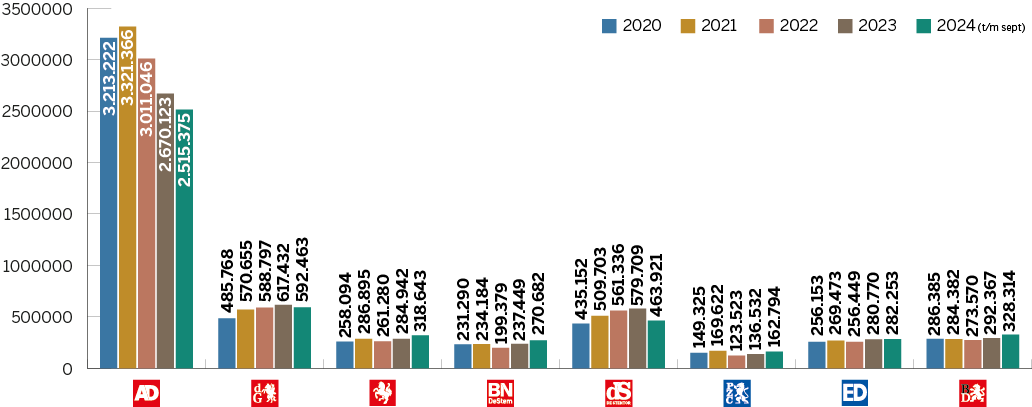
Journalisten in vaste dienst in 2024
Dit geeft de omvang van de redactie weer, omgerekend in voltijds banen (fte). Het zijn zowel de verslaggevers als de chefs, eindredacteuren, vormgevers, beeldredacteuren, video- en podcastmakers en onlineredacteuren. Om het beeld zuiver te houden zijn de freelance journalisten niet opgenomen. Die leveren eveneens een belangrijke bijdrage in de vorm van artikelen, columns, beeld, audio en video. Het zijn er soms honderden per titel. Aantal en werkzaamheden fluctueren van jaar tot jaar.

Meer info
Gemiddeld aantal unieke artikelen per dag
Dit is de hoeveelheid eigen artikelen die elke redactie produceert, van groot tot klein. De meeste redacties publiceren meer dan dat: bijvoorbeeld artikelen van de centrale redactie in het geval van de regionale kranten, of (in België) artikelen van collega-titels die worden doorgeplaatst. Die zijn niet meegeteld, net zo min als de kleine lokale berichten die automatisch worden gemaakt (zoals het weer en 112-berichten), of de doorgeplaatste artikelen van ‘Indebuurt’. Zo ontstaat het zuivere cijfer van wat de eigen redactie dagelijks maakt.

Meer info
Betalende abonnees
Dit is de som van papieren, digitale en hybride abonnementen. Het is het gemiddelde aantal over het desbetreffende jaar.

Rapportcijfers van eigen abonnees
Dit cijfer wordt gegeven door deelnemers aan een jaarlijks lezersonderzoek dat voor de meeste titels wordt gehouden.

Vertrouwenscijfer uit onderzoek
Dit cijfer is afkomstig uit recent onderzoek naar merkvertrouwen in opdracht van DPG Media. Daarbij geeft een algemeen publiek, dus niet alleen abonnees of bezoekers, vertrouwen in verschillende nieuwsmedia aan op een schaal van 0 (helemaal niet betrouwbaar) tot 10 (uiterst betrouwbaar). Daarnaast worden abonnees uitgesplitst, die hun titel doorgaans meer dan gemiddeld vertrouwen. Deze onderzoeksmethode en de uitkomsten komen overeen met die van het jaarlijkse Digital News Report van het Reuters Institute in Oxford. De Nederlandse en Vlaamse gemiddelde vertrouwenscijfers liggen in die monitor hoger dan die van nieuwsmedia in de omringende Europese landen.
Algemeen publiek
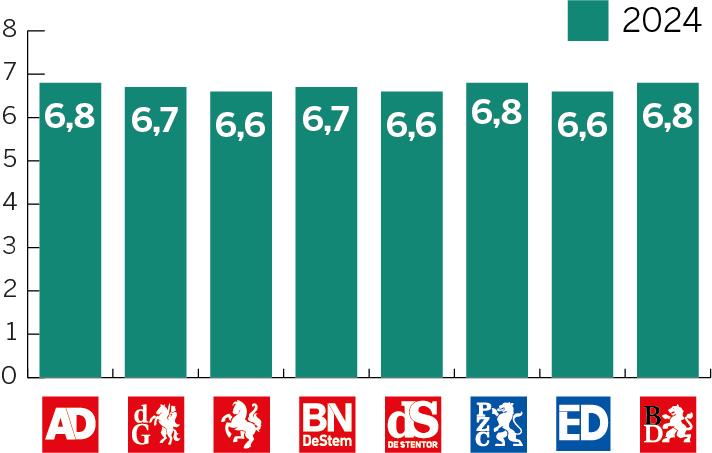
Abonnees
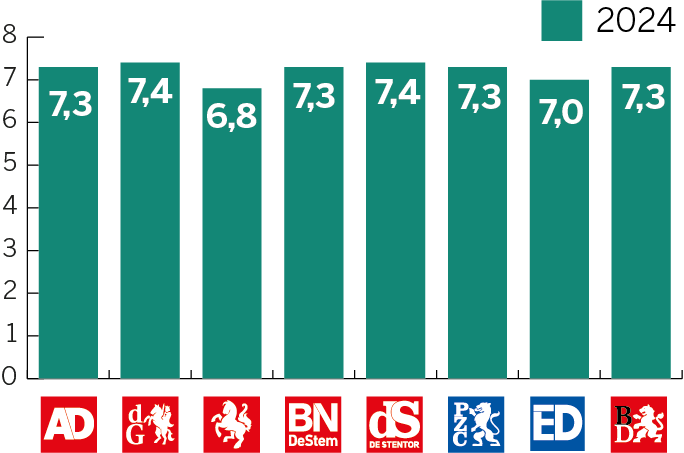
Aantal podcastafleveringen per jaar van alle titels
Deze cijfers geven aan hoeveel podcasts er door de verschillende titels zijn ontwikkeld.
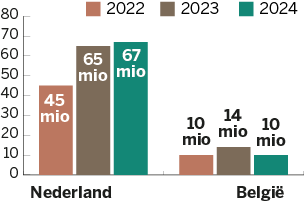
Gemiddeld aantal unieke video's per dag
Deze cijfers geven aan hoeveel video's er door de verschillende titels zijn ontwikkeld.
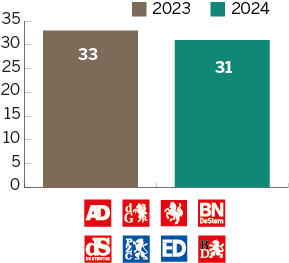
Dagelijks bereik
Gemiddeld dagelijks bereik
Het dagelijks bereik is een veelgebruikte indicatie van de impact die digitale journalistiek heeft. Maandbereik wordt ook weergegeven in de nationale monitors, maar daarin spelen eenmalige bezoekers van de sites een relatief grote rol.

Betalende abonnees
Betalende abonnees
Dit is de som van papieren, digitale en hybride abonnementen. Het is het gemiddelde aantal over het desbetreffende jaar.

Rapportcijfer van abonnees
Rapportcijfers van eigen abonnees
Dit cijfer wordt gegeven door deelnemers aan een jaarlijks lezersonderzoek dat voor de meeste titels wordt gehouden.

Journalisten in vaste dienst
Journalisten in vaste dienst in 2024
Dit geeft de omvang van de redactie weer, omgerekend in voltijds banen (fte). Het zijn zowel de verslaggevers als de chefs, eindredacteuren, vormgevers, beeldredacteuren, video- en podcastmakers en onlineredacteuren. Om het beeld zuiver te houden zijn de freelance journalisten niet opgenomen. Die leveren eveneens een belangrijke bijdrage in de vorm van artikelen, columns, beeld, audio en video. Het zijn er soms honderden per titel. Aantal en werkzaamheden fluctueren van jaar tot jaar.

Meer info
Unieke artikelen per dag
Gemiddeld aantal unieke artikelen per dag
Dit is de hoeveelheid eigen artikelen die elke redactie produceert, van groot tot klein. De meeste redacties publiceren meer dan dat: bijvoorbeeld artikelen van de centrale redactie in het geval van de regionale kranten, of (in België) artikelen van collega-titels die worden doorgeplaatst. Die zijn niet meegeteld, net zo min als de kleine lokale berichten die automatisch worden gemaakt (zoals het weer en 112-berichten), of de doorgeplaatste artikelen van ‘Indebuurt’. Zo ontstaat het zuivere cijfer van wat de eigen redactie dagelijks maakt.

Meer info
Vertrouwenscijfer uit onderzoek
Vertrouwenscijfer uit onderzoek
Dit cijfer is afkomstig uit recent onderzoek naar merkvertrouwen in opdracht van DPG Media. Daarbij geeft een algemeen publiek, dus niet alleen abonnees of bezoekers, vertrouwen in verschillende nieuwsmedia aan op een schaal van 0 (helemaal niet betrouwbaar) tot 10 (uiterst betrouwbaar). Daarnaast worden abonnees uitgesplitst, die hun titel doorgaans meer dan gemiddeld vertrouwen. Deze onderzoeksmethode en de uitkomsten komen overeen met die van het jaarlijkse Digital News Report van het Reuters Institute in Oxford. De Nederlandse en Vlaamse gemiddelde vertrouwenscijfers liggen in die monitor hoger dan die van nieuwsmedia in de omringende Europese landen.
Algemeen publiek
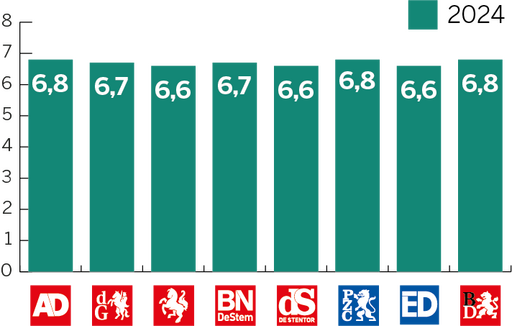
Abonnees
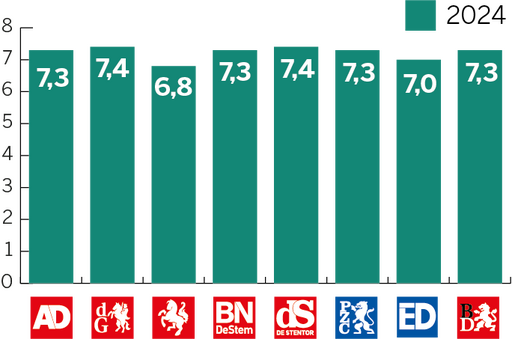
Aantal podcastafleveringen
Aantal podcastafleveringen per jaar van alle titels
Deze cijfers geven aan hoeveel podcasts er door de verschillende titels zijn ontwikkeld.

Aantal unieke video's
Gemiddeld aantal unieke video's per dag
Deze cijfers geven aan hoeveel video's er door de verschillende titels zijn ontwikkeld.

